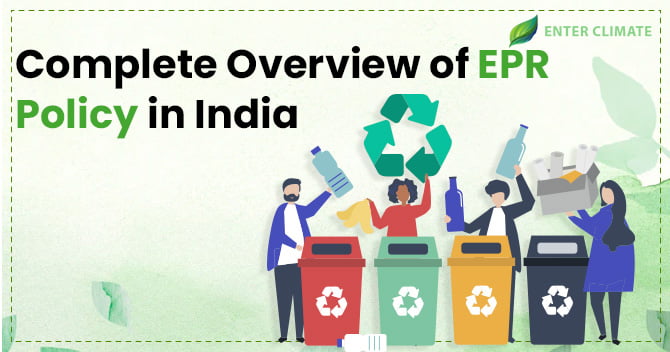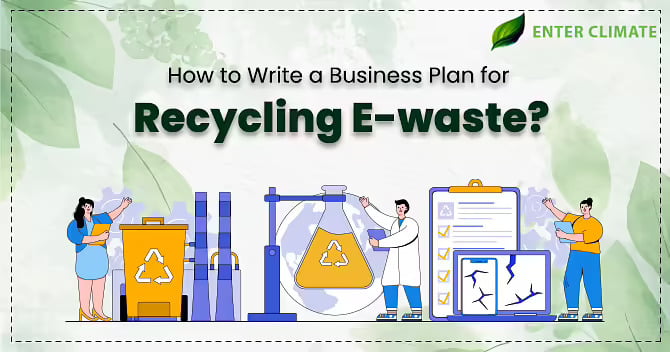How to draft a detailed E-waste Business Plan?
 30 Sep, 2022
30 Sep, 2022 
Based on any model, a business must be able to meet its objectives and create profit for its owners in a limited period. When it comes to competitive and upcoming businesses, such positive growth indicators must be exhibited as soon as possible to assess the business approach and make necessary changes within time. The same is true for the e-waste business too, which is based on the recovery of usable parts from e-waste. When it comes to specific Electrical and Electronic Equipment (EEE) that has precious metals in it, the e-waste business plan must be based on strong scientific and technical expertise. Therefore, starting an e-waste business requires a detailed plan based on exhaustive market research and must target profitable core activities like metal and component recovery.
While the disposal of hazardous elements in e-waste can be left to the treatment, storage, disposal and facilities (TSDFs)operator, the rest of the activities can be managed within a single e-waste recycling facility. Electronic waste management is done according to the E-waste Management Rules, 2016. According to these rules, all those engaged in recycling e-waste must go through the registration, authorisation, and obtain (No Objection Certificates) NOCs and permits for specific activities.
The functions of the e-waste recyclers include disassembling along with recovery operations. There is no constraint on the type of operations that recyclers can permit, provided they have the requisite facilities and obtain the necessary licences. While finalising an e-waste business plan, the following factors must be kept in mind –
- Establish goals and objectives for the business.
- Finalise the specific waste which will be dealt with, its quantity and the source of procuring the waste.
- Set targets for decreasing the amount of waste sent to the landfill.
- Describe recycling/reuse methods for each material finalised in the first stage.
- Identify the market for the recovered resources and transportation, including what will be segregated for reuse or recycling and what will be sent for disposal to landfills.
- Studying standard operating procedures issued by SPCB/PCC and the CPCB for handling waste.
- Procedure for training the workforce about the protocols, safety measures and mitigation measures in case of accidents.
Stages in designing an E-waste Business Plan
Researching the e-waste management industry
Before starting a waste management business and proceeding with drafting an e-waste business plan, the decision for the type and the extent of recycling must be zeroed upon. A less experienced or new entrepreneur should pick a niche in which he can specialise and gradually diversify. E-waste management businesses have great demand, which is bound to increase exponentially in the future. To manage the entire waste lifecycle, registered entities like Producer Responsibilities Organisation (PRO) do the collection, dismantling, recycling and disposal of hazardous waste. So if the entity has previous experience in profitably managing important stages like collection and dismantling, a wider number of facilities can be planned.
The detailed e-waste business plan can be based upon the following core activities –
Collection system–Businesses that act as drop-off points for end-of-life e-waste or provide services like take back and buyback systems or door-to-door collection will require connections with Original Equipment Manufacturers (OEMs), traders, importers, transporters, PROs, etc.
Dismantling– Dismantling is the most crucial stage in e-waste management. Thus, this business requires an elaborate e-waste business plan. A dismantler has to create robust networks with collection centres and traders for sourcing e-waste; do careful dismantling; manage and dispose of the hazardous waste in the process and collaborate with recycling entities like refurbisher and precious metal extraction facilities.
Treatment and disposal of hazardous e-waste – Non-recyclable and hazardous waste have to be disposed of as per the SOPs given by the CPCB from time to time. Moreover, proper planning regarding post-compliance for storage, treatment, co-processing and disposal of waste must also be done before deciding the niche for the business.
Planning for financial and non-financial investment for the business -Drafting the next stage in the e-waste business plan requires planning the finances needed to gather the assets like buildings, machinery, equipment and software. The waste management business is vast and consists of small and large businesses. To ease the problem, one should reflect on various elements such as budget, individual potential and scope of the business. Every niche in the e-waste industry requires different means and modes for the waste recycling process.
Conducting market research -Before stepping into the market or even making a detailed e-waste business plan, one must know how the market is going, who potential competitors are and what the pricing is. Compiling this information and then comparing it with your costs will give you an approximate idea of the revenue that you would be generating. If the competition in a specific niche is tough, one must consider tweaking the course of business. Closely observe different e-waste management activities and focus on a business that you find interesting.
Obtaining licences and permits for the recycling activity, you want to manage
An e-waste recycling facility is by itself an industrial operation requiring clearances from various authorities for the establishment and operations of the units. Some licences must be obtained before starting the operation. Therefore, having an e-waste business plan and execution of this stage is of utmost importance for the establishment’s overall setup and smooth functioning. The licences and documents needed in this regard are –
Registration of the unit: Any e-waste business must obtain a registration certificate to establish its legal identity in the eyes of the law. The owner can apply for registration of the business fromDigital India Corporation (DIC) or any agency with authority to do so.
Obtaining Consent to Establish: Next in formulating an e-waste business plan is the Pollution Under Control (PUC) certificate (CTE and CTO). The unit must initially approach the SPCB for the Consent to Establish (CTE) certificate, also called No Objection Certificate (NOC), in many cases before establishing the e-waste management unit. CTE is issued to e-waste management facilities under the Water Act of 1974 and the Air Act of 1981. The applicant must submit documents like –
- Duly filled application form of concerned SPCB
- Signed undertaking
- Site or layout plan along with the roadmap
- Detailed project report
- Layout plan
- Details of the manufacturing process including a list of machinery, the capital cost of the unit (land, building, and plant machinery), water balance, source of water, and the quantity required
- Land documents such as rent /lease agreement
- Industry registration documents
- Any other document given in the application form
Obtaining Consent to Operate (CTO): The concerned SPCB/PCC issues CTO to e-waste management facilities after an inspection of their facilities by the site inspection authorities. Documents required for this NOC include –
- Duly filled application
- Copy of CTE issued
- Consent application fee
- Gross capital investment certificate
- Land-ownership documents (rent/lease agreement, porcha, etc.)
- Site plan with road map/route map project
- List of machines, raw materials and process flowchart
- Test reports for emission/effluent from the facility (done within the last year)
Note: Consolidated Consent and Authorisation or CCA is a consolidated consent NOC issued after CTEto starts the unit and authorises the activity at the same time (for example, dismantling of e-waste) are provided simultaneously after the applicant fulfils various terms and conditions of discharge standards and clears the site inspection stage.
Authorisation process by SPCB: Authorisation for e-waste facilities is mandatory to ensure the proper waste management generated in the process. Refurbishing, recycling, repairing and dismantling units often involve handling hazardous waste. Therefore, the CPCB regulates these activities by issuing authorisation for these activities. The application process for authorisation can be challenging. Thus, proper guidance and assistance are needed in this field. This, in return, can aid in making ane-waste business plan easier. The following documents are needed to obtain authorisation –
- Duly filled application form
- Consent to Establish granted by the SPCB
- Registration Certificate issued by District Industries Centre
- Proof of installed capacity and machinery issued by the District Industries Centre
- Process flow chart for E-waste management
- Proof of air pollution control devices
- Details of effluent treatment mechanism
- Registration with authorised treatment, storage and disposal operator
- Authority letter/power of attorney
- Details of arrangements installed for recycling e-waste and managing hazardous waste
- Copy of allotment letter
Additional Licences and Permits: A few permits will be required in addition to the ones mentioned above, depending on the nature and requirements of the business. These include –
- Factories licence
- Fire NOC
- BIS certification
- UdhyamAadhaar
- Hazardous Waste Management authorisation
Conclusion
When your e-waste business is up and running, it is vital to abide by the post-compliance and updated guidelines of all concerned Pollution Control Boards[1]. Whether you start a small or big business, a detailed business plan always helps. The same goes true in the case of an e-waste business plan. Planning is needed for starting and managing the business. No defined format guarantees smooth inception, running and growth of your business. Proactive steps like analysing the merits and demerits of a business based on the services it offers, the location of the business, return on investments, etc., are essential factors.
Read our Article: How to Set Up Refurbished Mobile E-waste Management Business?













